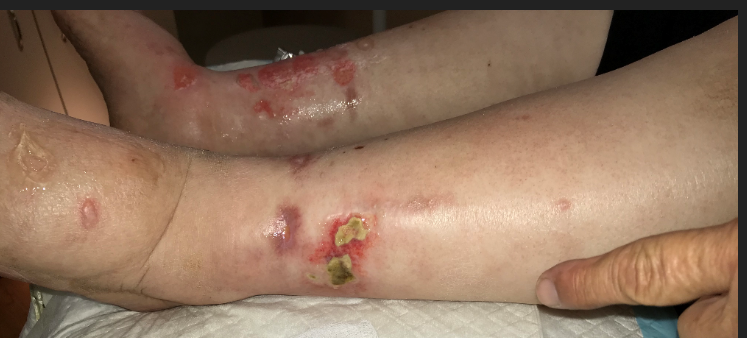This is an elderly woman who developed a confirmed Influenza A infection back in February. Her husband says that these painful leg lesions began almost immediately after starting Oseltamivir (Tamiflu®). She was referred to me five months later, and the husband was frustrated because he said he had told several physicians about the sudden onset of the painful leg lesions in conjunction with Oseltamivir but no one seemed to listen. I hoped she might respond to a few days of gentle compression (I did arterial screening and her arterial supply was excellent) but even though the edema improved, she still had new lesions develop.
In the meantime, I made a lot of phone calls to her cardiologist and her primary care doctor to confirm she actually had no heart failure issues and in fact, the Nurse Practitioner at her primary’s office remembered seeing her for a possible allergic reaction to Oseltamivir. It seemed obvious to me that she had a case of vasculitis, either from the influenza itself or the Tamiflu. The husband was not very willing for the wife to undergo a biopsy and truthfully, even though I have an excellent dermatopathologist to read them, the biopsy is often inconclusive and we still give a trial of prednisone. Naturally the lady is a diabetic.
I decided to try a low dose of prednisone rather than the usual whopping dose (since her clinical course had been smoldering for five months) and her response to only 10 mg of Prednisone per day was impressive. No new lesions and the pain gone. With advice from Dr. Jimmy Schmidt (my go-to dermatologist for rare and frustrating dermatological cases locally), we decided to try a low dose of Dapsone (25 mg) and it’s working without dropping her hemoglobin too much (don’t forget to obtain a G-6-PD level before you start Dapsone). The lesions have all resolved except one very deep, necrotic lesion that’s going to take a long time.

Leucocytoclastic vasculitis (LCV) can be triggered by practically anything – with infections and medications at the top of the list. Unfortunately, a number of cases of LCV have been reported after influenza vaccination. I don’t think that’s what happened here, based on the time course. However, with flu season approaching, I thought it was time to raise awareness of this unusual “wound complication” that might be related to influenza.
We had a bad flu season. A recent news article reports that an estimated 80,000 Americans died of flu and its complications last winter — the highest flu death toll in at least four decades. The season peaked in early February. In addition to a very virulent strain of influenza, the vaccine didn’t work very well. However, individuals who were vaccinated were less likely to die and their illness was less severe. It’s time for healthcare providers to get their flu shots, and you might keep your eyes open for LCV. The other thing not to miss – we should listen to the patient’s story.

Dr. Fife is a world renowned wound care physician dedicated to improving patient outcomes through quality driven care. Please visit my blog at CarolineFifeMD.com and my Youtube channel at https://www.youtube.com/c/carolinefifemd/videos
The opinions, comments, and content expressed or implied in my statements are solely my own and do not necessarily reflect the position or views of Intellicure or any of the boards on which I serve.




Thanks for sharing this information.